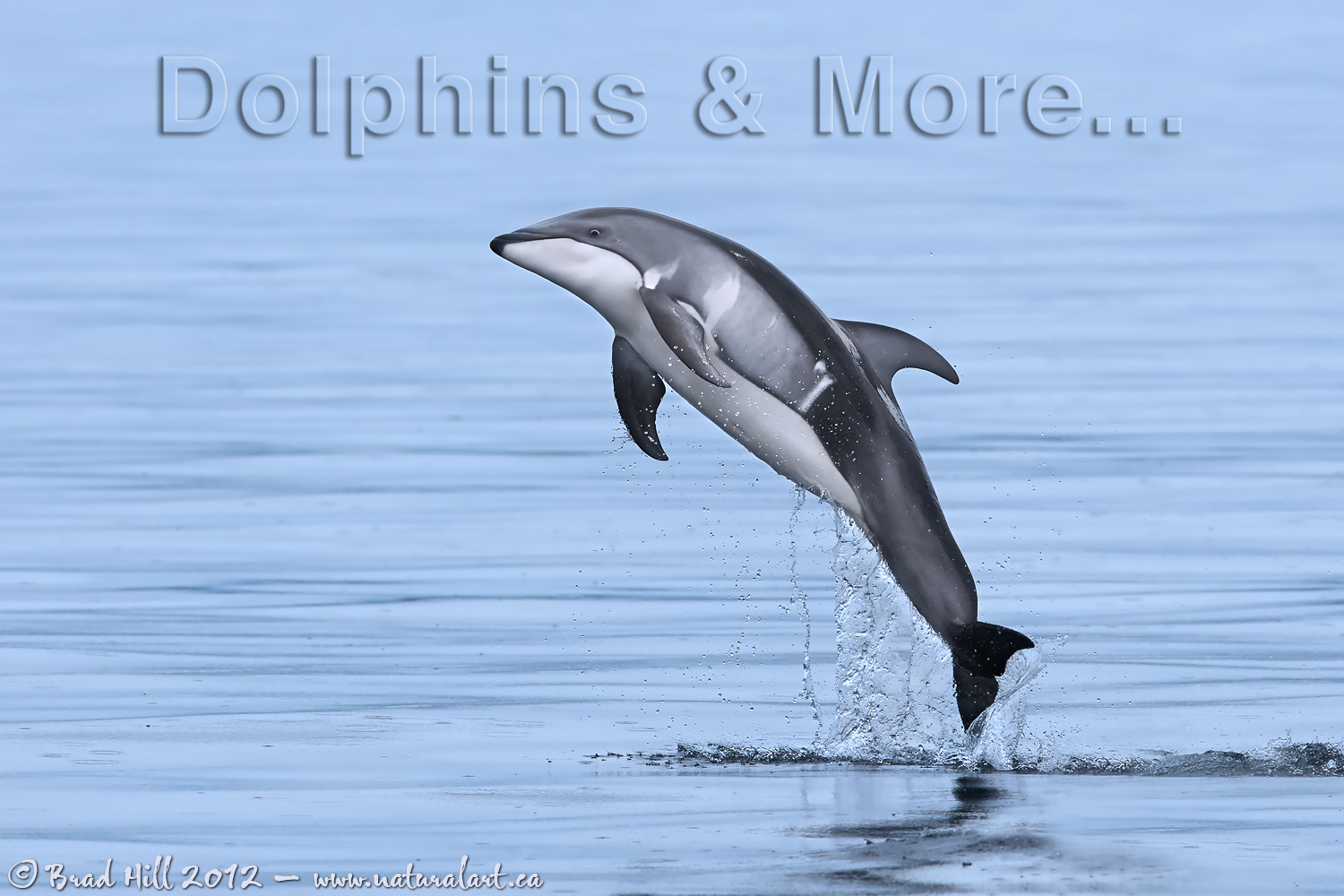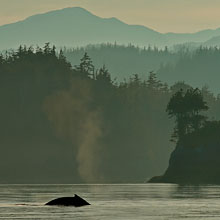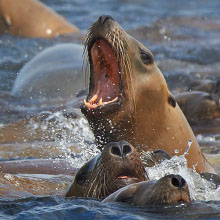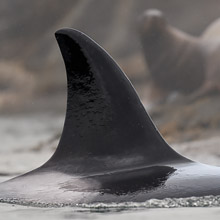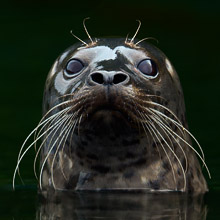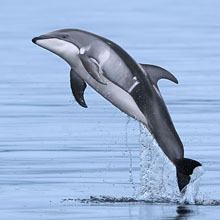Availability: Undetermined - Enquiries?
In the Field
Jumping for Joy? Northern Vancouver Island, BC, Canada. August 23, 2012.
View additional Dolphin (and MORE!) images beginning here: Dolphins & More...
There's almost nothing that's more fun to photograph than a pod or super-pod of dolphins, especially if you catch them during a time when they're "feeling their oats" and taking to the air. This particular dolphin is a Pacific White-sided Dolphin - one of the liveliest dolphin species found in the northern Pacific. Besides being highly energetic and almost "exuberant" they're highly intelligent - some argue that they have the mental capacity of about a 7- or 8-year-old child (so about 22% more brain power than most federal politicians).
I've mentioned many times that one way to captivate viewers is to capture behaviors or poses that they can somehow relate to - something that evokes emotion in them. With dolphins finding a "relatable behaviour" is easy - almost everything they do exudes "fun". It's hard not to smile and think "Wow! That looks like fun!" when you see an image of a dolphin soaring above the water. You almost can't find a description of a dolphin in popular literature that doesn't include phrases like "fun-loving" or "entertaining". Almost everything we see them doing - be it riding the bow wave of a boat or leaping out of the air - seems to most like it would be great fun! Heck, even the "default" facial expression looks like a smile. I personally think that describing so much of a dolphin's behavioural repertoire and/or species-wide personality as driven by seeking "fun" is completely off-the-mark and one of the most extreme forms of anthropomorphism (for example, I'm convinced that when riding bow-waves they are actually trying to drive a perceived competitor or "disturbance" away from a food source - what better way to do it than swarm their head?). But regardless of what motivates dolphins to do what they do one thing is absolutely certain - as photographic subjects they're both super-challenging and super-fun!
But seeing a dolphin doing something that looks like fun and capturing a quality image of it are two entirely different things. Capturing this breaching dolphin was no easy feat. Even when they really get into the leaping "mood" figuring out just where they're going to leave the water is incredibly tough - they move so fast that the next leap can be almost anywhere. And it happens just so, so fast. Once you get a glimpse or hint of where one is going to leap, you have to swing around and start shooting almost simultaneously. Even though good "gimbal" style tripod heads allow you to move quickly, the only way I could swing my 400mm lens around fast enough to capture this shot was to hand-hold it. And using a camera (in this case a Nikon D4) with both a lightning quick autofocus system and a very high frame rate, while not absolutely essential to get the shot, greatly increases your chances of success. You simply can not "time" your shot to get the dolphin fully out of the water (or, for that matter, wait for your camera to attain focus) - you pretty much have to "let it rip". And ripping at 10 fps ups your chances of getting the shot just right a whole lot (compared to "letting it kinda rip" at 4 fps!).
Here's a higher resolution (2400 pixel) version of the image for your perusal (enjoy!):
• Jumping for Joy? Download 2400 pixel image (JPEG: 1.0 MB)
NOTES:
1. This image - in all resolutions - is protected by copyright. I'm fine with personal uses of it (including use as desktop backgrounds or screensavers on your own computer), but unauthorized commercial use of the image is prohibited by law. Thanks in advance for respecting my copyright!
2. Like all wildlife photographs on this website, this image was captured following the strict ethical guidelines described in The Wildlife FIRST! Principles of Photographer Conduct. I encourage all wildlife photographers to always put the welfare of their subjects above the value of their photographs.
3. This image was captured during my "Humpback, Orcas, Sea Lions & More" photo tour in August of 2012. Each year I offer trips into two different parts of the Great Bear Rainforest as well as one to photograph aquatic mammals and oceanscapes near the northern tip of Vancouver Island. And, in selected years, I also offer photo tours to locations to capture other highly sought-after subjects, such as various owl species of the boreal forest and wildlife of Canada's Arctic. Details about these trips can be found on the Photo Tours page of this website.
Behind the Camera
Jumping for Joy? Northern Vancouver Island, BC, Canada. August 23, 2012.
Digital Capture; RAW 14-bit format; ISO 800.
Nikon D4 paired with Nikkor 400mm f2.8 VRII lens. Hand held. VR on and in normal mode.
1/2000s @ f8; +0.67 stop compensation from matrix-metered exposure setting.
At the Computer
Jumping for Joy? Northern Vancouver Island, BC, Canada. August 23, 2012.
RAW Conversion to 16-bit TIFF, including first-pass/capture sharpening using Capture One Pro Version 7. Three raw variants (processed from raw) differing by a total of 1.0 stops in exposure.
Further digital corrections on resulting 16-bit TIFF files using Adobe's Photoshop CS6 and Light Craft's Lightzone. Photoshop adjustments included compositing the raw conversion exposure variants, selective tweaks to exposure, selective colour desaturation, selective application of cooling filters (all of these using adjustment layers), and selective sharpening for web output. Final tone tweaking performed using tonemapper/re-light tool in Lightzone.
Conservation
Jumping for Joy? Northern Vancouver Island, BC, Canada. August 23, 2012.
Ten percent of the revenue generated by this image will be donated to Raincoast*.
Species Status in Canada**: Not listed as Endangered, Threatened, or of "Special Concern"
Nicknamed the "Lag", the Pacific White-sided Dolphin (Lagenorhynchus obliquidens) is known for its exuberance and is one of the liveliest dolphins in the northern Pacific. They commonly leap clear of the water, perform flips and somersaults, and will often approach and ride the bow waves of ships.
Lags will often form schools of 1,000 or more individuals. Their social lives are dynamic, with groups frequently joining together and breaking apart. Even though both sharks and killer whales commonly feed on them, they frequently have long life spans and some have lived for 40 or more years in the wild!
*The Raincoast Conservation Society (and Foundation) is an effective and efficient organization that has been fighting for protection of this unique habitat. If you are looking for a meaningful way to contribute to the conservation of this amazing ecosystem, Raincoast will provide maximal "bang" for your conservation dollars.
**as determined by COSEWIC: The Committee on the Status of Endangered Wildlife in Canada












